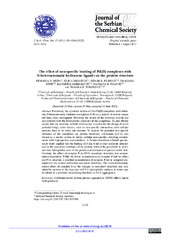Приказ основних података о документу
The effect of non-specific binding of Pd(II) complexes with N-heteroaromatic hydrazone ligands on the protein structure
| dc.creator | Mijin, Nemanja D. | |
| dc.creator | Milošević, Jelica | |
| dc.creator | Filipović, Nenad R. | |
| dc.creator | Mitić, Dragana | |
| dc.creator | Anđelković, Katarina | |
| dc.creator | Polović, Natalija Đ. | |
| dc.creator | Todorović, Tamara R. | |
| dc.date.accessioned | 2022-12-13T10:54:33Z | |
| dc.date.available | 2022-12-13T10:54:33Z | |
| dc.date.issued | 2022 | |
| dc.identifier.issn | 0352-5139 | |
| dc.identifier.uri | http://aspace.agrif.bg.ac.rs/handle/123456789/6237 | |
| dc.description.abstract | Previously, the cytotoxic actions of five Pd(II) complexes with bidentate N-heteroaromatic chelators (complexes 1–5) on a palette of several cancer cell lines were investigated. However, the results of the cytotoxic activity did not correlate with the hydrophobic character of the complexes. To gain further insight into the structure–activity relationship, essential for the design of novel potential drugs, other factors, such as non-specific interactions with cellular proteins, have to be taken into account. To explore the potential non-specific influence of the complexes on protein structures, ovalbumin (OVA) was chosen as a model system to mimic cellular non-specific crowding environments with high protein concentrations. A Fourier-transform infrared spectroscopy study implied that the binding of 3 and 4 led to only moderate alternations in the secondary structures of the protein, without the possibility to penetrate into hydrophobic core of the protein and disruption of protein native fold. Contrary, the effect of complex 5 on OVA secondary structures was concentration-dependent. While the lower concentration of complex 5 had no effect on OVA structure, a doubled concentration of complex 5 led to complete disruption of the content native-like secondary structures. The concentration-dependent effect of complex 5 on the changes in secondary structures and considerable increase in the exposure of OVA hydrophobic surfaces to water may be related to a potential crosslinking that leads to OVA aggregation. © 2022 Serbian Chemical Society. All rights reserved. | |
| dc.language | English | |
| dc.relation | info:eu-repo/grantAgreement/MESTD/inst-2020/200168/RS// | |
| dc.relation | info:eu-repo/grantAgreement/MESTD/inst-2020/200288/RS// | |
| dc.rights | openAccess | |
| dc.rights.uri | https://creativecommons.org/licenses/by/4.0/ | |
| dc.source | Journal of the Serbian Chemical Society | |
| dc.source | Journal of the Serbian Chemical Society | |
| dc.subject | DMSO effect | |
| dc.subject | ligand hydrophobicity | |
| dc.subject | ovalbumin model system | |
| dc.subject | protein aggregation | |
| dc.title | The effect of non-specific binding of Pd(II) complexes with N-heteroaromatic hydrazone ligands on the protein structure | |
| dc.type | article | en |
| dc.rights.license | BY | |
| dc.citation.epage | 1156 | |
| dc.citation.issue | 10 | |
| dc.citation.rank | M23 | |
| dc.citation.spage | 1143 | |
| dc.citation.volume | 87 | |
| dc.identifier.doi | 10.2298/JSC220518050M | |
| dc.identifier.fulltext | http://aspace.agrif.bg.ac.rs/bitstream/id/24250/The_effect_of_non_PUB_2022.pdf | |
| dc.type.version | publishedVersion |


